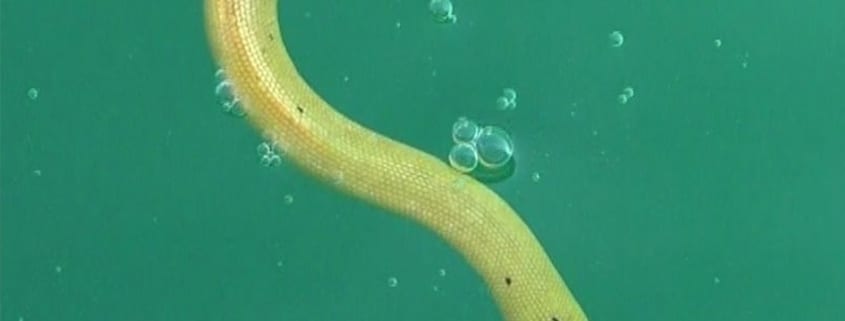New Sea Snake Subspecies from Rainforest Trust Project Site Described
Geographic isolation between related species can lead to unexpected differences between them. For example, two related plant species on nearby islands may have different leaf shapes. Two related bird species separated by a mountain range might have different songs. But recently, scientists found some truly distinctive differences between related populations separated only by a modest ridge of sand.
This July, researchers described a new subspecies of Yellow-bellied Sea Snake (Hydrophis platurus) in a paper in ZooKeys. The new subspecies, the Yellow Sea Snake (Hydrophis platurus xanthos), is endemic to Golfo Dulce, an isolated gulf on the Pacific coast of Costa Rica.
One of the new subspecies’ unique qualities is its color. Most specimens of Yellow-bellied Sea Snakes found in the open Pacific have black backs and yellow undersides. In contrast, the new subspecies is yellow on both its back and underside. The researchers argue that this differential may stem from higher water temperatures. Golfo Dulce is an inlet, semi-isolated from the rest of the Pacific by a shallow ridge near the ocean. This ridge keeps water from flowing in or out of the gulf. In this semi-isolated inlet, the tropical sun can heat the water warmer than in the ocean. Scientists believe the black backs of Yellow-bellied Sea Snakes are useful to gather heat amongst the chilly Pacific waters. In the warmer waters of Golfo Dulce, this trait might be irrelevant.
In addition, the Yellow Sea Snake differs from the Yellow-bellied Sea Snake in hunting behavior. The researchers found Yellow Sea Snakes hunting at night while Yellow-bellied Sea Snakes hunt during the day. The new subspecies also hunts in turbulent water while Yellow-bellied Sea Snakes hunt in smooth water. But the strangest contrast was in the snake’s shape. Yellow-bellied Sea Snakes hunt stretched out in a straight line but researchers spotted the new subspecies hunting in an “s”-shape. Snakes of the new subspecies fold themselves up and place their faces, mouth open, in the water — a unique posture for a unique snake in a unique body of water.

“Whether endemic to an island, mountain, lake, or gulf,” the paper notes, “any population confined to such a narrow habitat that is affected by human activity is at risk of decline and potential extirpation.” This description could not be more apt to Golfo Dulce.
Besides the sea snake, the warm waters of the gulf support Critically Endangered Hawksbill Turtles and Endangered Green Turtles and Whale Sharks. The gulf is vital nursery habitat for Endangered Scalloped Hammerheads and home to many other shark species. Despite this incredible biodiversity, Golfo Dulce faces ongoing human pressure. The researchers note that the Yellow Sea Snake has been a recent target of some collectors. Sharks and rays in the gulf face pressure from both targeted fishing and bycatch.
Katie Pugh, Rainforest Trust’s Invertebrate and Aquatic Species Conservation Officer said,
“The discovery of this sea snake highlights the impressive biodiversity of the gulf and the importance of this site not only for marine megafauna, but also for a wide variety of less charismatic species that are in need of protection.”
Rainforest Trust is working with local partner Misión Tiburón to create a 172,974-acre multi-use Marine Management Area. With the support and involvement of local fishing communities, these new protections will protect the vital marine habitat of Golfo Dulce.




